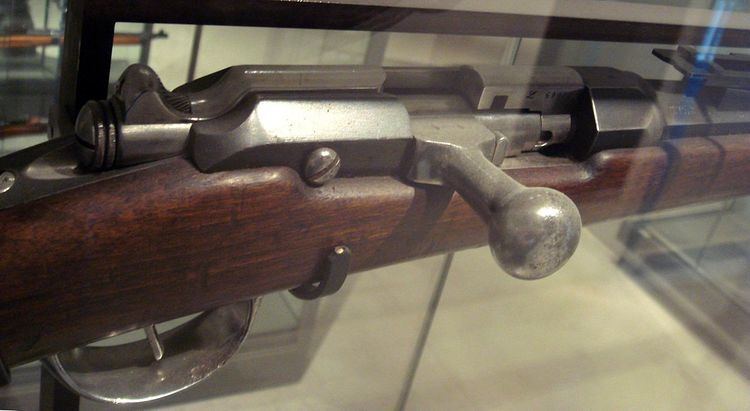Type Bolt-action rifle | Place of origin France Designed 1874 | |
 | ||
Used by ChileFranceKingdom of GreeceMonaco Wars French colonial expeditionsSino-French WarWar of the PacificChilean Civil War of 1891Thousand Days' WarGreco-Turkish War (1897)Balkan WarsWorld War IGreco-Turkish War (1919–22)Spanish Civil WarWorld War II | ||
The Fusil Gras Modèle 1874 M80 was a French service rifle of the 19th century. The Gras used by the French Army was an adaptation to metallic cartridge of the Chassepot breech-loading rifle by Colonel Basile Gras.
Contents
Description
This rifle had a caliber of 11mm and used black powder centerfire cartridges that weighed 25 grams. It was a robust and hard-hitting weapon, but it had no magazine and so could only fire one shot after loading. It also had a triangular-shaped sword bayonet, known as the Model 1874 "Gras" sword bayonet. It was replaced by the Lebel rifle in 1886, the first rifle to use smokeless gunpowder. In the meantime, about 400,000 Gras rifles had been manufactured.
The metallic-cartridge Gras was manufactured in response to the development of the metallic cartridge designed by Colonel Boxer in 1866 (Boxer cartridge), and the British 1870 Martini-Henry rifle. Those were soon emulated by the Germans with the 1871 Mauser.
The Hellenic Army adopted the Gras in 1877, and it was used in all conflicts up until the Second World War. It became the favourite weapon of Greek guerrilla fighters, from the various revolts against the Ottoman Empire to the resistance against the Axis, acquiring legendary status. The name entered the Greek language, and grades (γκράδες) was a term colloquially applied to all rifles during the first half of the 20th century. It was manufactured by Manufacture d'armes de Saint-Étienne, one of several government-owned arms factories in France. However most of the Gras rifles (60,000) used by the Hellenic military were manufactured under licence by Steyr in Austria.
The Gras rifle was partly the inspiration for the development of the Japanese Murata rifle, Japan's first locally-made service rifle.
According to the Vietnamese historian Phạm Văn Sơn, a Vietnamese general in the Hương Khê uprising, named Cao Thắng (1864-1893), managed to copy the design of "a 1874 type fast-firing rifle of French". However, the Vietnamese version did not have a rifled barrel, and the range was limited.
